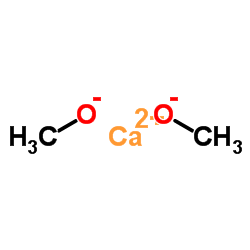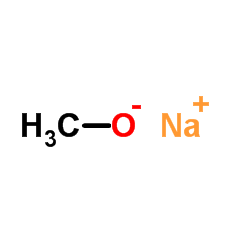Calcium methoxide

Calcium methoxide structure
|
Common Name | Calcium methoxide | ||
|---|---|---|---|---|
| CAS Number | 2556-53-8 | Molecular Weight | 102.146 | |
| Density | N/A | Boiling Point | 48.1ºC at 760 mmHg | |
| Molecular Formula | C2H6CaO2 | Melting Point | >385 °C(lit.) | |
| MSDS | Chinese USA | Flash Point | 11.1ºC | |
| Symbol |


GHS05, GHS07 |
Signal Word | Danger | |
| Name | calcium,methanolate |
|---|---|
| Synonym | More Synonyms |
| Boiling Point | 48.1ºC at 760 mmHg |
|---|---|
| Melting Point | >385 °C(lit.) |
| Molecular Formula | C2H6CaO2 |
| Molecular Weight | 102.146 |
| Flash Point | 11.1ºC |
| Exact Mass | 101.999367 |
| PSA | 18.46000 |
| LogP | 0.19420 |
| Vapour Pressure | 265mmHg at 25°C |
|
Section 1: Product Identification Chemical Name:Calcium methoxide, min. 90% (balance methanol) CAS Registry Number:2556-53-8 Formula:Ca(OCH3)2 EINECS Number:219-873-6 Chemical Family:metal alkoxide Synonym:calcium methylate in wood spirits, wood alcohol
Section 2: Composition and Information on Ingredients IngredientCAS NumberPercentACGIH (TWA)OSHA (PEL) Title Compound2556-53-890%no datano data methanol67-56-110%200ppm260mg/m3 Section 3: Hazards Identification Irritating to skin, eyes, and respiratory system. Methanol may cause blindness, intoxication, dizziness, coma Emergency Overview: and death. Primary Routes of Exposure:Inhalation, ingestion, contact with skin and eyes. Eye Contact:Causes severe irritation of the eyes. Delayed blindness may occur through atrophy of the optic nerve. Skin Contact:Causes moderate irritation of the skin. Methanol vapor may be irritating to the respiratory tract and cause headache, dizziness, coma, and blindness. Inhalation: Ingestion:Ingestion may cause gastrointestinal distress, blindness, convulsions and coma. Irritating to skin, eyes and respiratory tract, cause nausea and vomiting, intoxication, blindness, convulsions, Acute Health Affects: and coma. Prolonged exposure may damage eyes, kidneys, and liver, and cause permanent blindness. In animal studies Chronic Health Affects: methanol has acted as a mutagen and reproductive effector. NTP:No IARC:No OSHA:No SECTION 4: First Aid Measures Immediately flush the eyes with copious amounts of water for at least 10-15 minutes. A victim may need Eye Exposure: assistance in keeping their eye lids open. Get immediate medical attention. Wash the affected area with soap and water. Remove contaminated clothes if necessary. Seek medical Skin Exposure: assistance if irritation persists. Remove the victim to fresh air. Closely monitor the victim for signs of respiratory problems, such as difficulty Inhalation: in breathing, coughing, wheezing, or pain. In such cases seek immediate medical assistance. Ingestion:Seek medical attention immediately. Keep the victim calm. Give the victim water (only if conscious). SECTION 5: Fire Fighting Measures Flash Point:48.2°F (methanol) Autoignition Temperature:no data Explosion Limits:6-36% (methanol) Extinguishing Medium:carbon dioxide, dry powder or foam If involved in a fire, fire fighters should be equipped with a NIOSH approved positive pressure self-contained Special Fire Fighting Procedures: breathing apparatus and full protective clothing. Hazardous Combustion andIf involved in a fire this material may emit toxic organic fumes. Decomposion Products: Unusual Fire or Explosion Hazards: Highly flammable. Formation of explosive air/vapor mixtures is possible in presence of moisture. SECTION 6: Accidental Release Measures Eliminate all ignition sources. Avoid contact with water. Small spills may be adsorbed into diatomaceous earth, Spill and Leak Procedures: sand, or other suitable adsorbent, and swept up. SECTION 7: Handling and Storage Store in a tightly sealed container in a cool dry place. If container is left open, product may adsorb moisture Handling and Storage: and carbon dioxide from the atmosphere and release methanol vapor. SECTION 8: Exposure Controls and Personal Protection Eye Protection:Always wear approved safety glasses when handling a chemical substance in the laboratory. Skin Protection:Wear protective clothing and gloves. Ventilation:Material may form a vapor upon exposure to air. if possible, handle the material in an efficient fume hood. If ventilation is not available a respirator should be worn. The use of respirators requires a Respirator Respirator: Protection Program to be in compliance with 29 CFR 1910.134. Ventilation:Material may form a vapor upon exposure to air. if possible, handle the material in an efficient fume hood. Additional Protection:No additional protection required. SECTION 9: Physical and Chemical Properties Color and Form:off-white pwdr. Molecular Weight:102.15 Melting Point:no data Boiling Point:no data Vapor Pressure:not applicable Specific Gravity:no data Odor:woody alcohol odor Solubility in Water:Reacts with water SECTION 10: Stability and Reactivity Stability:air and moisture sensitive solid Hazardous Polymerization:no hazardous polymerization Conditions to Avoid:Keep away from moisture, heat and ignition sources including open flame and electrostatic discharge. Incompatibility:water, mineral acids, alkali metals, oxidizing agents, acid chlorides, and halogens Decomposition Products:Carbon dioxide, carbon monoxide, organic vapors, and metal oxides and carbonates. SECTION 11: Toxicological Information No information available in the RTECS files for title compound. Methanol: eye (rbt) draize: moderate; oral (human) TDLo: 3571 ul/kg; oral (human) TDLo: 9450 ul/kg; oral (human) LDLo: 6422 mg/kg; oral (human) RTECS Data: LDLo: 428 mg/kg; inhalation (human) TCLo: 86000 mg/m3; inhalation (human) TCLo: 300 ppm; inhalation (rat) LC50: 64000 ppm/4h. Carcinogenic Effects:No data available Mutagenic Effects:Methanol: Mutagen Tetratogenic Effects:Methanol: Reproductive effector SECTION 12: Ecological Information Ecological Information:No information available SECTION 13: Disposal Considerations Disposal:Dispose of according to local, state and federal regulations. SECTION 14: Transportation Shipping Name (CFR):Flammable solids, Organic, N.O.S. Hazard Class (CFR):4.1 Additional Hazard Class (CFR):NA Packaging Group (CFR):II UN ID Number (CFR):UN# 1325 Shipping Name (IATA):Flammable solid, Organic, N.O.S. Hazard Class (IATA):4.1 Additional Hazard Class (IATA):NA Packaging Group (IATA):II UN ID Number (IATA):UN# 1325 SECTION 15: Regulatory Information TSCA:Listed in the TSCA inventory. SARA (Title 313):Title compound not listed. Second Ingredient:Methanol (CAS# 67-56-1): listed in TSCA and SARA. SECTION 16 - ADDITIONAL INFORMATION N/A |
| Symbol |


GHS05, GHS07 |
|---|---|
| Signal Word | Danger |
| Hazard Statements | H302-H315-H318-H332 |
| Precautionary Statements | P280-P305 + P351 + P338 |
| Personal Protective Equipment | dust mask type N95 (US);Eyeshields;Gloves |
| Hazard Codes | Xn:Harmful; |
| Risk Phrases | R20/22;R36/38;R41 |
| Safety Phrases | S24-S26-S36-S45 |
| RIDADR | NONH for all modes of transport |
| WGK Germany | 3 |
|
~% 
Calcium methoxide CAS#:2556-53-8 |
| Literature: Journal of the Chemical Society, , p. 704 |
|
~% 
Calcium methoxide CAS#:2556-53-8 |
| Literature: EP1961726 A1, ; Page/Page column 4 ; |
|
~% 
Calcium methoxide CAS#:2556-53-8 |
| Literature: US6372947 B1, ; Page column 5-6 ; |
|
~% 
Calcium methoxide CAS#:2556-53-8 |
| Literature: Journal of the Chemical Society, , vol. 95, p. 159 - 165 Proceedings of the Chemical Society, London, , vol. 23, p. 304 - 305 Diss. Berlin 1908, p. 24 |
|
~% 
Calcium methoxide CAS#:2556-53-8 |
| Literature: US6372947 B1, ; Page column 5-6 ; |
|
~% 
Calcium methoxide CAS#:2556-53-8 |
| Literature: R. Istit. Lombardo Sci. Lettere Rendic. (2), , vol. 68, p. 126 - 128 Ca: MVol.B3, 89, page 845 - 848 |
| Precursor 3 | |
|---|---|
| DownStream 0 | |
| Calcium dimethanolate |
| Methanol, calcium salt (2:1) |
| Methanol,calcium salt |
| calcium hypochlorite |
| Calcium methoxide |
| calcium methanolate |
| methanol,calcium methylate |
| calcium methylate |
| EINECS 219-873-6 |
| Methanol,calcium salt(2:1) |
| MFCD00058816 |
| Methanol,Calciummethylat |





